C6N1 Model 11 &
C6N1-S Night Fighter
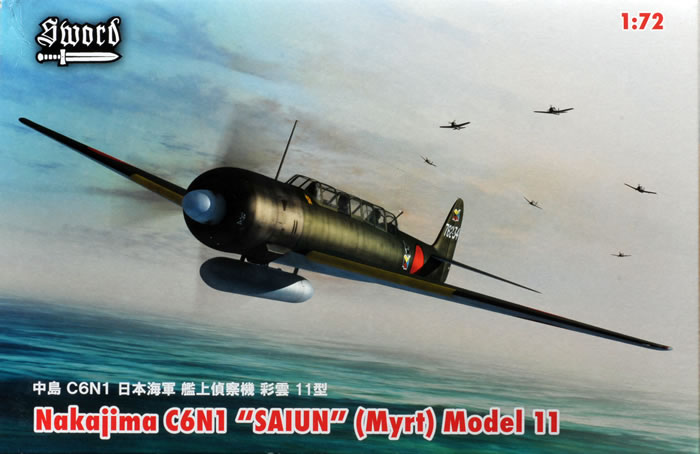
Sword, 1/72 scale
S u m m a r y : |
Catalogue Number: |
Sword Kit Nos.:
SW72073 - C6N1 Saiun (Myrt) Model 11
SW72076 - C6N1-S Saiun (Myrt) Night-Fighter |
Scale: |
1/72 |
Contents & Media |
Both kits have sixty-four grey and three clear styrene parts in common, whilst SW72076 has an additional five grey cannon parts and three alternative canopy pieces. SW72073 has decals for four colour scheme options; whilst SW72076 has just two. |
Price: |
Available on-line from these stockists: |
Box #
Version |
Hannants |
Squadron |
Modelimex |
West Coast
Hobbys |
Hobbylink Japan |
SW72073
C6N1 |
£14.99 |
US$34.99 |
€14.58 |
Can$21.00 |
¥2,200 |
SW72076
C6N1-S |
£14.99 |
US$34.99 |
€15.58 |
Can$19.50 |
¥2,200 |
Click here for currency conversion. |
Review Type: |
First Look. |
Advantages: |
These are good quality kits with very nice surface and interior detail. Their level of internal detail is a significant improvement over the earlier Fujimi kits in this scale. |
Disadvantages: |
Paint colour information is generic, and there is no clear direction on whether or not to fit the arrestor hook.
Three canopy cuts must be made for the night-fighter version, where complete canopies would have been better. |
Conclusions: |
Well-engineered, the night-fighter canopy aside, and produced to high standards for limited-run kit, they look to be very straightforward to build, with the potential to produce attractive and interesting models.
At around the same price as the Fujimi kits in many markets, they offer a real advance in interior detail over the older kit. However, externally the two brands are generally equal, so do there is no need to dispose of your Fujimi Saiuns, but do opt for Sword over Fujimi if you are in the market for a new one - Definitely recommended. |
Reviewed by
Mark Davies

Sword's 1/72 scale Myrts are available online from
Squadron.com
Pacific war experience clearly demonstrated a need for a fast and long-ranged carrier-based reconnaissance aircraft. In early 1942 Nakajima began development of an aircraft to meet this requirement for the Imperial Japanese Navy. The result was the C6N Saiun (Painted Cloud), a sleek three-seat design incorporating laminar flow wings with double-slotted Fowler flaps and leading-edge slats; it was powered by a 1,830-hp Nakajima Homare 11 radial engine. The first prototype flew in May 1943, but its performance was disappointing, especially at higher altitudes. A further eighteen prototype and development aircraft followed. Those with the 1,990-hp Homare 21 engine delivered close to required performance with a 379-mph maximum speed, and this engine was the one selected for production aircraft.
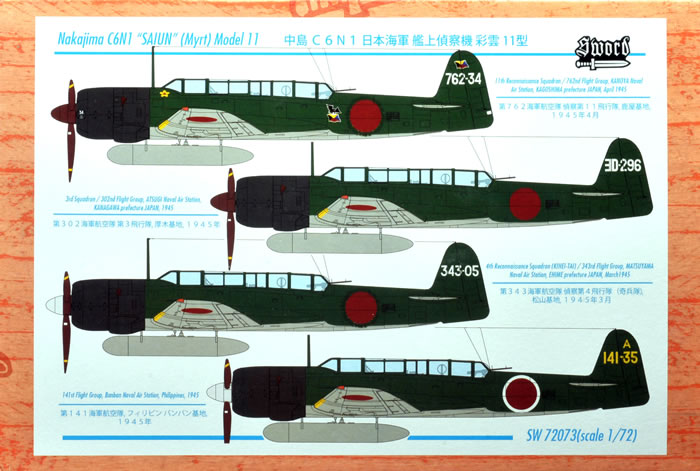
Production began in early 1944 and the Allies allocated the reporting name of 'Myrt' when it entered service in the summer of 1944. It proved sufficiently fast to usually prevent its interception by US fighters. Like many Japanese mid-war designs, it was a case of too little, too late; also accompanied by engine reliability problems. A total of 463 were built by August 1945 when production ended. This total included a few C6N1-S two-seat night-fighter conversions of the C6N1 aircraft; with either a single 30-mm or twin 20-mm oblique upward-firing cannons, but lacking radar. Various other versions were developed, including a torpedo-bomber, but by the IJN's carrier force was all but spent. The Saiun did have the distinction of being the last aircraft to be shot down during WW2, just five minutes before the end of hostilities.
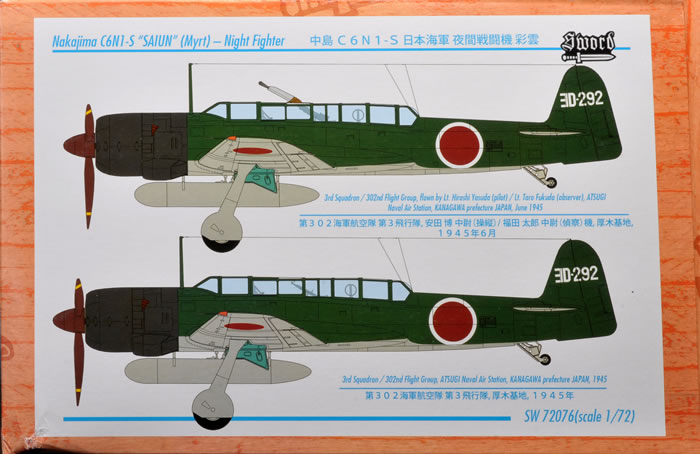
Previous 1/72 Scale C6N1 Saiun Kits
I am aware of several previous C6N kits in 1/72 scale, although most have long since disappeared from stockist's shelves. The most widely known are injected kits by Fujimi and Aoshima. Both have been released in multiple boxings, covering several versions in Fujimi's case. The Fujimi kit is typical of the brand's early to mid-1990's releases - Generally simple construction, complicated a little by the need to cover several versions, fine recessed surface detail, but with quite basic cockpit and engine detail. Aoshima's kit is of an earlier vintage; if it is like their other releases from the 1960's it is probably more suited to kit collecting than building as a scale replica. Other brands to have offered 1/72-scale Saiun kits at some stage include; Air Flash, Antares, Cruver, MPM, Miyazawa, and Red Baron; whilst Nitto had a 1/75-scale offering.
For most, Fujimi's kit has been the only serious and most available contender, albeit that Fujimi kits can be hard to find in some markets. Sword's Saiun kit will no doubt be welcomed by many IJN aircraft fans.
Sword versus Fujimi Comparison
My review will include a running comparison of points of interest between the Sword and Fujimi kits, and this is supported by images of Fujimi parts in the accompanying images with a blue background.
Contents
The kits, which share the same sprues, come in typically Czech end-opening boxes with digital artwork on their front. The plastic parts and decals come in a large zip-lock plastic bag, with the clear parts further enclosed in a small bag of their own.
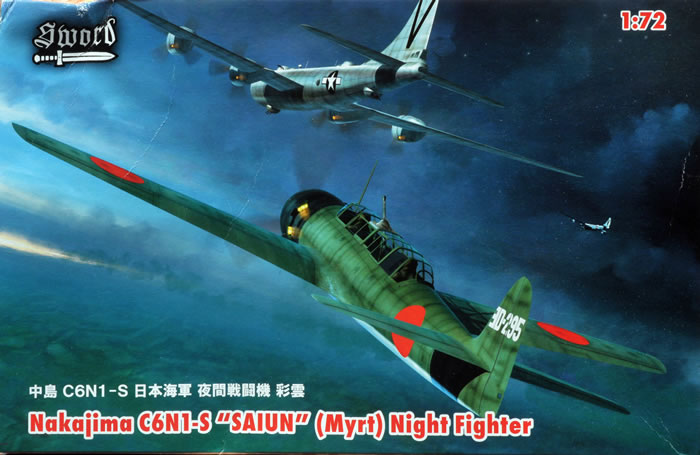
The instructions provide a parts map and easy to follow diagrammatic assembly format. The diagrams are well drawn, and in fact far better than some mainstream brands. There is also a brief history of the aircraft. Generic paint colours are given in Czech and English, with all other text in English. The painting and decal guides use adequate black & white shaded four-view drawings in the instructions, with coloured profiles on the box rear. I feel that Sword could have done a lot better here, and describe the correct colours using IJN names, FS-595 equivalents, and/or model paint range cross-references.
The Kit
It is a typical Sword kit, with cleanly moulded parts that have very fine surface detail, and narrow sprue gates. In fact, it has some of the best moulding I have seen from this company, with really delicate small parts. There is just a hint of flash in a few places, but this is easy to deal with. There are no resin parts, unlike many earlier Sword kits. Parts break down is largely conventional for the type.
Cockpit detail is a huge advance on the Fujimi kit, and is very comprehensive for an all-styrene effort. The seats have no harnesses moulded with them, but it will be worth adding homemade or PE belts to dress things up some more. There is a lot of sidewall detail moulded integrally with the fuselage halves, and some more for the lower rear cockpit walls moulded two individual panels. These mount directly below the integral detail, which will need some ejector pin stubs removed for the panels to fit. I think that the panels may also need to have their rear faces thinned down to get the best fit. There is one sink mark in the lower portion of the radio casing, but this will be hard to see, and can be easily remedied anyway. Two windows fit in the ventral area in-front and behind the centre crewmember's seat; there is also camera to mount over the rearmost of these applicable to the reconnaissance version.
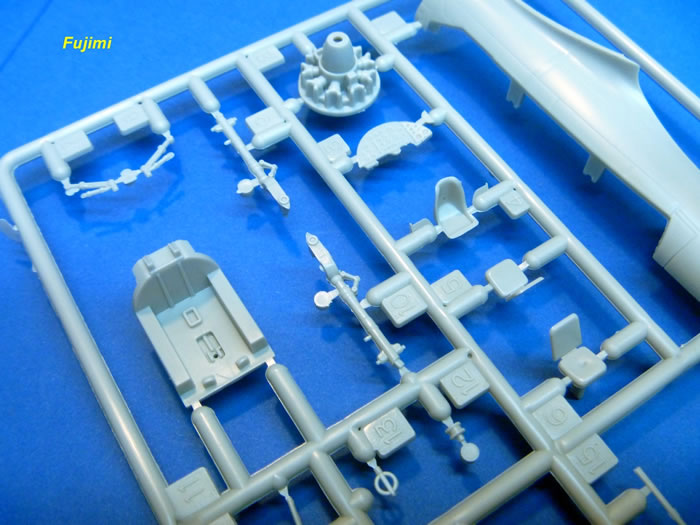
The rear-defence gun is beautifully moulded and very fine, whilst Fujimi's rendition is rather average and looks a bit like a Browning .30-cal.
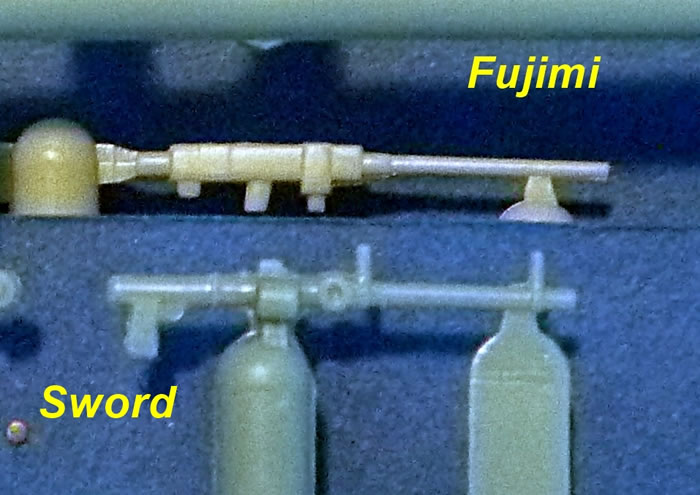
Sword provides the choice of twin 20-mm or a single 30-mm oblique cannon for their C6N1-S boxing. (Note that these are on a separate sprue and not shared with the otherwise identical sprues of the C6N1 boxing.) These cannon and their mounts are adequately detailed, and better than the single 30-mm cannon provided with Fujimi's C6N1-S.

Note that the 30-mm cannon appears to have had a canvas boot around the barrel where it protrudes through the canopy (see image below).

The clear parts are commendably clear and thin, but this cockpit has enough detail to justify an open canopy. Cutting the kit item will not work as its thickness will make the sliding sections sit too high. I should think that the Falcon or Pavla vac-form canopies intended for the Fujimi kit will probably work, or maybe Rob Taurus will release one specifically for the Sword kit. The C6N-S night-fighter has two alternative mid-sections to accommodate either a single or twin cannons, and a rearmost portion without an aperture for the rear defence gun, as this was absent from this version. The result is that the one-piece canopy suited to the C6N1 reconnaissance version must be carefully sawn and cleaned up in three places so that the night-fighter parts can be inserted. Three alternate but complete canopies would be far more preferable, and would have needed only a little more tooling than Sword's approach.

The airframe is a very straightforward affair, and I envisage these kits being quite quick to assemble. Comparison of the major Sword parts with Fujimi's reveals close to 100% dimensional and outline agreement (I did not cut the parts from the sprues however for a truly precise comparison).
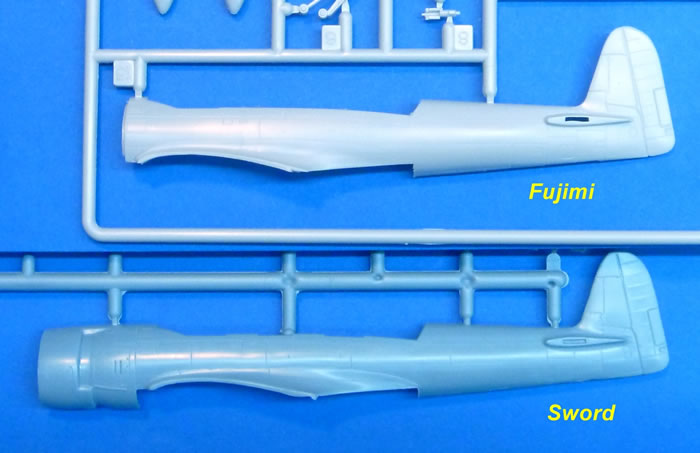
The engine has a simple one-piece moulding for the twin-rows of cylinders; but this is fine, with slightly better definition than Fujimi's. Added to this is the reduction gear cover and ignition harness piping. The engine is enclosed by a close-fitting cowl, and is further obscured by the prop and spinner. The prop blades are reasonable as far as injected kits go, but they will still benefit from at least some thinning. I did notice that Sword's prop blades are about 0.5-mm longer than Fujimi's (about 1.5 scale inches), whilst the Fujimi prop has noticeably finer section blades.
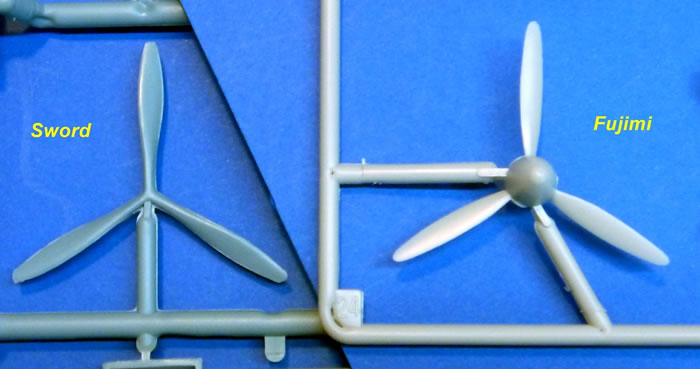
Sword's engine exhaust stacks are moulded with the separate cooling gills, although these can only be modelled closed as supplied.
Sword's wings have separate wheel-well interiors with far superior detail to Fujimi's. However, I expect that some thinning or other adjustment may be needed to sandwich these between the wing halves.
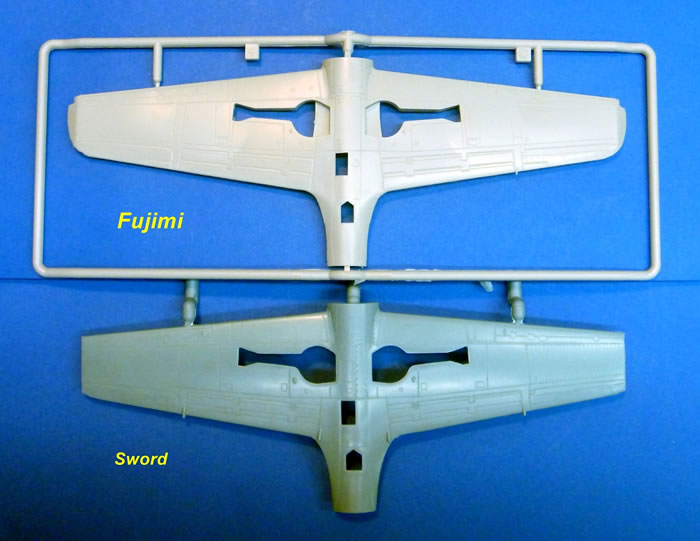
Sword's wingtip navigation lights are moulded solid, whereas Fujimi provides separate clear parts for these. Fujimi has the added refinement of a two-piece metal pitot (wire and tube), whereas Sword directs the modeller to scratch-build this item. Both kits include a large drop tank.
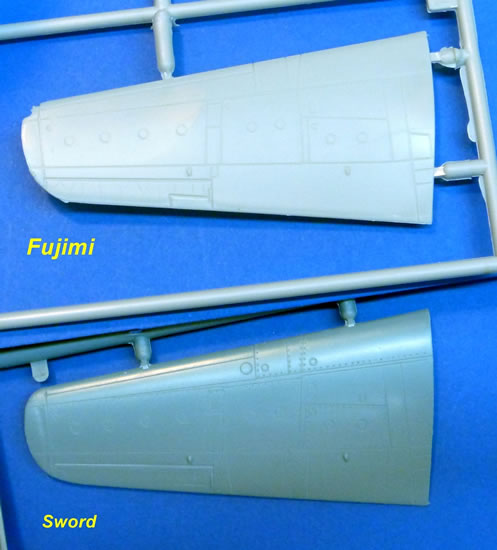
The undercarriage is nicely detailed, and includes retraction links for the inner doors; something that the Fujimi kit lacks. Sword's undercarriage legs are equal to Fujimi's, but the wheels are not quite as crisply moulded as result of limited versus long-run tooling. It just means a bit more cleaning up is needed in Sword's case. Sword's main-wheels have spoked hubs on one side, whilst Fujimi's are plain on both, but have weighted tyres that are flattened and slightly bulged. Sword's spokes may be more correct, but they will be unseen as the main undercarriage doors cover them. Both kits have nicely done tail-wheels; Sword's has a canvas boot whereas Fujimi's does not.
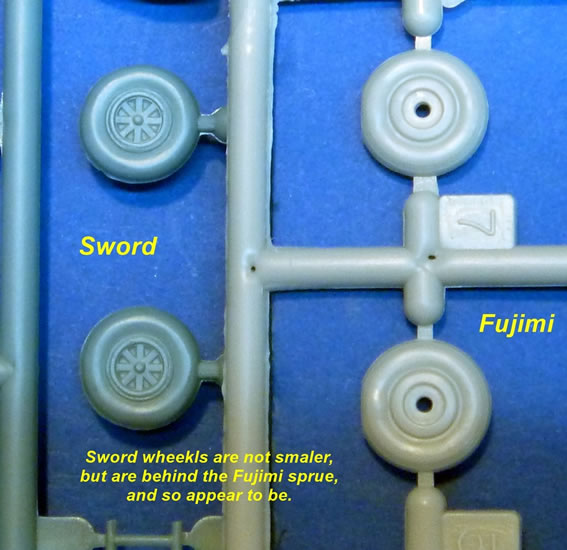
Both kits have arrestor hooks, but only Sword supplies a blanking cover for versions where this was omitted. The Sword instructions indicate that the hook is optional, but provide no guide as to which option should be used for each markings option. In fact, the shaded colour schemes included with the instructions show the hook fitted in all cases, and yet the colour profiles on the box rear show the hook as being absent! So check your references; although I would expect that since all the kit options are land-based that the hook would have been deleted.
Overall, I should think that these new Sword kits should be simple and enjoyable ones to build. They have a clear internal detail advantage over their Fujimi predecessors, but the Japanese kit is sure to offer a better fitting build, and in terms of external appearances equals the Czech kit. If you own Fujimi already I would say keep it, but if you are in the market for a Saiun then buy Sword.
Marking Options
Sword's decals well registered and appear to have good opacity. I am sure they will prove to be excellent to apply based on my experience of this brand. Pleasingly, they include the drift stripes for the horizontal stabilisers as single-piece decals, thus ensuring the various spacing and angles of the stripes are defined (unlike some kits where they came as a single decal strip to be cut and placed as individual stripes). The subjects covered are:
Box # SW72073 - C6N1:

-
11th Reconnaissance Squadron, 762nd Flight Group, Kanoya Naval Air Station, Kagoshima Prefecture Japan, April 1945.
-
3rd Squadron, 302nd Flight Group, Atsugi Naval Air Station, Kanagawa Prefecture Japan, 1945.
-
4th Reconnaissance Squadron (Kihei-Tai), 343rd Flight Group, Matsuyama Naval Air Station, Ehime Prefecture Japan, March 1945.
-
141st Flight Group, Banban Naval Air Station, Philippines, 1945.
Box # SW72076 - C6N1-S:
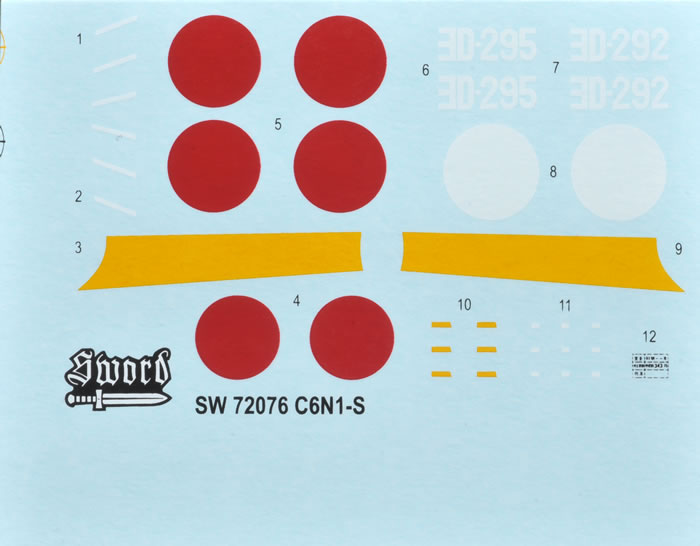
-
3rd Squadron, 302nd Flight Group, flown by Lt Hiroshi Yasuda (pilot) & Lt Taro Fukuda (observer) Atsugi Naval Air Station, Kanagawa Prefecture Japan, June 1945.
-
3rd Squadron, 302nd Flight Group, Atsugi Naval Air Station, Kanagawa Prefecture Japan, 1945.
These are good quality kits with very nice surface and interior detail. Paint colour information is generic, and the shaded diagrams do not mention the main airframe colours. Most modellers will know which colours to use, but Sword is behind its competitors in this respect.
Well-engineered, the night-fighter canopy aside, and produced to high standards for limited-run kit, they look to be very straightforward to build, with the potential to produce attractive and interesting models.
At around the same price as the Fujimi kits in many markets, Sword offer a real advance in interior detail over the older kit. However, externally the two brands are generally equal, so do there is no need to dispose of you Fujimi Saiuns; but do opt for Sword over Fujimi if you are in the market for a new one.
Definitely Recommended.
Thanks to Sword Models for this review sample.
Review Text & Blue Background Images Copyright © 2013 by Mark Davies
Black Background Review Images Copyright © 2013 by Brett Green
Page Created 13 December, 2013
Last updated
13 December, 2013
Back to HyperScale Main Page

|
